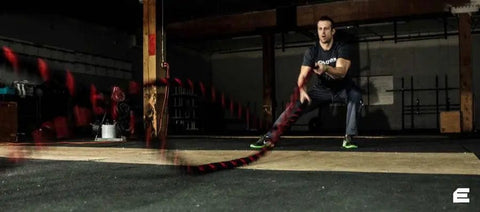Battle Rope Buyer's Guide
Sep 22, 2017Jordan Lindstrom

When I was first introduced to battle ropes I figured they were all essentially the same. They are, after all, a pretty simple piece of fitness equipment. I've now been using, testing and experimenting with battle ropes going on three years, working with local athletes and CrossFit gyms (here in the Leaveworth WA area) to develop battle ropes that work well in fitness center and garage gym settings.
After all this testing and experimenting, here's what I've discovered matters with battle ropes:
Material is your most important consideration. You have essentially three material options when buying a battle rope:
I'd recommend good Poly Dacron: Poly Dacron rope is made from polypropylene and dacron plastic fibers. These synthetic fibers are twisted into strands, with the Dacron providing the strength in the outer braid. Polypropylene provides a lightweight core and additional strength. Using polypropylene for the core reduces weight and cost and makes the rope lighter.
The main benefit of poly dacron is that it doesn't shed. Manila ropes perform great if you're only using them outside, but they are a little more expensive and they shed little fibers every time you use them, which can be a pain to clean up if you're inside. Manila ropes are also 10% to 25% more expensive than comparable polydac ropes. I'd only recommend manila if you want a more organic product (manila is made from hemp plant fibers) or if you only plan to use these outside.
If you go with a polydac rope, it's helpful to differentiate between "cheap" polydac and "good" polydac. The truth is "polydac" has becoming something of a marketing term, with lots of wiggle room in the manufacturing process for how that material is created and what ratio of polypropelen to dacron blend is used. It's hard to explain until you've actually held a cheap rope in your hand or tried to use it, but they feel more fibrous and they are definitely less fluid than either good polydac or manila ropes. Fluidity is key during a battle rope workout.
How to tell between cheap and good polydac? I hate to say it, but price is the easiest way, as most manufacturers won't discuss what blend level they use. Our ropes are 80% Dacron, 20% Polypropylene, which we've found to be the optimum blend for durability and fluidity. Anything greater than 30% Polypropylene has that more fibrous feel. One easy way identify a "cheap" rope: look at the 1.5" x 30ft option ... If it's less than $60 buyer beware. We've worked with many manufacturers, and the only way I've found to get the price down that low is to reduce the quality.
A couple additional material notes:

You can find our battle rope sizing guide here. Here's the scoop with length:
I recommend: All things being equal, and if you’re unsure of which one to get, I recommend the 50 foot length. The longer rope will not necessarily make the workout harder, but will definitely make your motions more "fluid". The shorter lengths can slap and catch because your undulations won't make it all the way down the rope before they hit the anchor point and send feedback back through the rope.

You have a few options when it comes to thickness: 1.5", 2" or 2.5". I'd recommend 1.5" for pretty much everyone. Why? Battle ropes can be used to build both strength and endurance, but the thicker ropes will simply kick your but. I've seen even the strongest/fittest CrossFit guys burn out on a 2" rope in 30 seconds.
If you're new to battle ropes (not matter who you are), start with a 1.5" rope. If you're experienced and think you're ready for another challenge, go for a 2". If you're Superman or the Hulk (and you have massive hands), try a 2.5".
We're all about equipping and encouraging people to take on big challenges, because we know the process of doing hard things helps us grow in character and capacity.
Frequently bought together
You may also like
3 Comments
Hey Jordan,
Thanks for the advice, battle ropes felt like a move that would keep things exciting but I was unsure which to purchase.
I am going for a decent 38mm 12-15m.
Cheers,
I need your products with fob prices list
I’m really interested in a battle rope just starting out help please